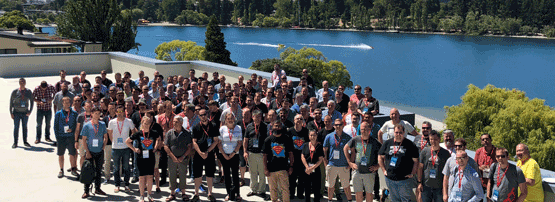
NZNOG 2018 was held in beautiful Queenstown. The conference attracted more than 150 attendees who experienced brilliant weather (and scenery) when they were not inside with the conference.
The conference was opened by New Zealand’s Minister of Broadcasting, Communications and Digital Media, Clare Curran, who outlined the new government’s priorities for the industry with a strong emphasis on inclusivity and individual rights in a digital age.
Next Ian Chiu gave a overview of Netflix operations from the perspective of ISPs, particularly those in New Zealand. Then Brad Cowie reviewed the status of the FAUCET open source SDN controller. FAUCET was again used to control the network for NZNOG this year and has dramatically improved in performance and stability since it was used last year.
After morning tea, Francesco Alberti talked about the EOLO network in north and central Italy and their project BLU to provide all their routing hardware and control. It was an interesting view of a network much larger than any wireless ISP in New Zealand. The hardware and software is very impressive.
The first afternoon session started with routing. Aftab Siddiqui gave an overview of the MANRS project and had trouble finding problem networks from New Zealand to highlight.
Following Aftab was a discussion on the Telecommunications Interception Capability and Security Act (TICSA). International visitors noted that NZ’s legislation covering network security and lawful intercept has quite strict obligations, and the police and National Cyber Security Centre reminded service providers of those obligations, making the point that time is running out to achieve compliance. Dave Mill introduced a new open source project, “OpenLI”, designed to help service providers to implement lawful intercept systems meeting ETSI standards.
The final session was primarily devoted to international cables. Both the Hawaiki and Tasman Global Access (TGA) submarine cable systems were presented with shots of the cable laying ships and termination facilities in New Zealand. Jamie Curtis talked of REANNZ’s (Research and Education Advanced Network New Zealand) plans to use the capacity Hawaiki will provide. The session finished with Richard Bayliss shortening his presentation of next generation Ethernet equipment to fit in a very diminished time slot.
The social evening started with a jet boat trip for most down the Kawarau river. Having 80 network engineers on one trip seemed an unanticipated national risk to some but the trip was completed successfully and all returned safe even if some were a bit damp.
Thursday morning’s first session covered open source network management tools. First up Tarus Balog covered OpenNMS, followed by Jose Leitao and Daniel Rodriguez talking about the infrastructure Facebook has built to actively monitor their clusters, and the versions of the tools that have been publicly released.
In the next session, Geoff Huston (APNIC) looked at attacks on the DNS and why NSEC caching is part of the solution. He also showed NZ stats for DNSSEC validation (impressive) and signing (not impressive at all).
Throughout Friday there was a network analytics theme. Egor Krivosheev from Vocus discussed his experience of modern network tools – mostly looking at collecting data using streaming telemetry. Later Rada Stanic (Cisco) reviewed details of Model driven telemetry showing how it becomes a foundation for moving network measurement to a big data analytics framework. After lunch, NZRS’s Daniel Griggs described his experiences of using Clickhouse and Grafana to monitor the .nz DNS infrastructure, with Tim Raphael from NZIX describing the analytics infrastructure being deployed at IX-Australia and NZIX.
The history of application protocol usage was covered in some novel research presented by Shane Alcock from WAND (a research group at the University of Waikato Computer Science Department). He showed there were distinct trends in the numbers and types of applications protocols being developed that reflected different periods of Internet evolution.
The final presenter was Kraig Winters who covered his experience of the New Zealand Red Cross IT and Telecommunications Emergency Response Unit providing tools in disaster response situations around the world. In particular, he went through details of the systems they use and are developing to be able to provide faster, more reliable and more sophisticated support of disaster relief efforts when primary infrastructure is not available.
You can watch all the sessions from NZNOG 2018 on NZNOG’s YouTube channel.
Richard Nelson is a Senior Lecturer in the Computer Science Department at the University of Waikato.
The views expressed by the authors of this blog are their own and do not necessarily reflect the views of APNIC. Please note a Code of Conduct applies to this blog.
